Compiled by the owners of Taipei City bookstore and studio Itis Edition (版語空間), Ordinary Beauty (普通美) encourages people to take a second look at the things around them.
The book includes photos of more than 100 objects gathered from variety and hardware stores in different Taiwanese cities. Some of the items will be on display at Good Cho’s (好,丘) until Jan. 15.
The objects include rubber rain boots in bright yellow and royal blue, plastic badminton shuttlecocks, and a bamboo birdcage purchased from the section of Heping West Road (和平西路) in Taipei, known as “bird street” (鳥街) for its cluster of stores selling avian pets. Some items, like a metal bottle that was filled with hot water and slipped in between bedsheets to warm them, were once a common part of daily life in Taiwan, but are now almost impossible to find on store shelves.
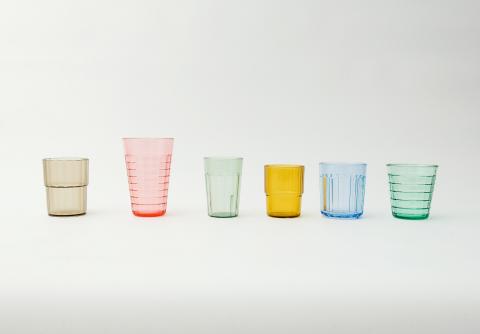
Photo: Catherine Shu, Taipei Times and courtesy of Itis Edition
While preparing the exhibit, Itis Edition owner Yihsin Wu (吳怡欣) considered the form, function and appearance of each object, with an emphasis on simplicity.
One of her favorite items is a soup ladle assembled from a metal cone and rod.
The design is “crude, but it’s also very smart,” says Wu.
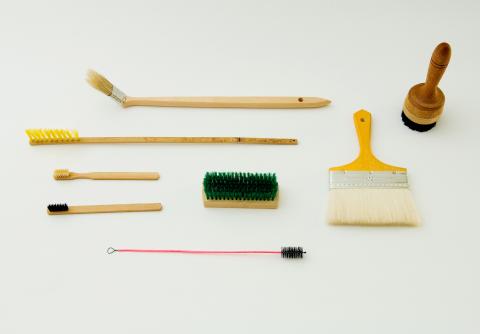
Photo: Catherine Shu, Taipei Times and courtesy of Itis Edition
A group of five mismatched plastic tumblers in delicate pastel colors are showcased in the Good Cho’s exhibit.
“You see cups like that all the time in restaurants and they are usually worn, so the surface is cloudy,” says Wu. “But then I found them brand new in a restaurant supply store and I was surprised, because they looked just like glass.”
Wu lived in New York City between 1997 and 2005, earning degrees at the School of Visual Arts and Pratt Institute. During that time, she met her husband, a photographer. The two spent their spare time collecting vintage magazines and poring over advertisements for now-obsolete objects.
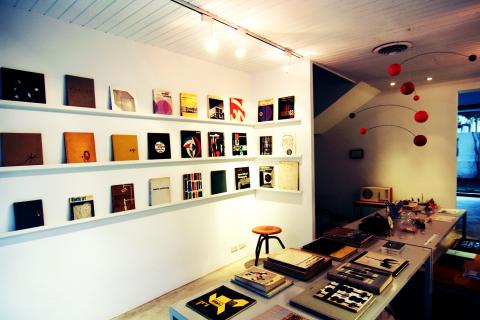
Photo: Catherine Shu, Taipei Times
“We ended up hunting for the actual products we saw pictured in the ads at secondhand stores,” says Wu. “So eventually our interest was not so much about the magazines, but the things we saw in them.”
While looking through thrift stores and flea markets for old items like radios, coffee grinders, dishware and chairs, Wu says she was struck by the difference between the products she had grown up with in Taiwan and what had been produced or used during the same time in the US. Even familiar objects took on a new sheen when she stumbled upon them.
“When you do finally start paying attention to them, it’s like ‘oh, these are fantastic!’” says Wu.
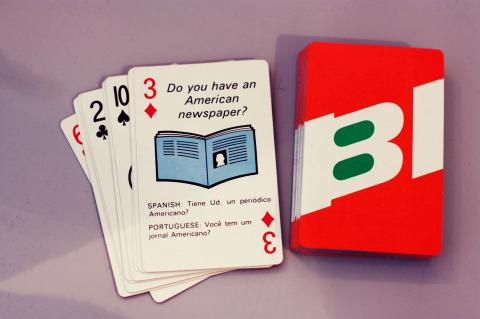
Photo: Catherine Shu, Taipei Times
Preparing Ordinary Beauty brought back the joy of discovering the elegance in even the most basic of household items.
During the six months they spent gathering objects for the book, Wu’s husband went down to a breakfast stand and was struck by the simplicity of a wire basket holding a batch of youtiao (油條), the fried dough sticks usually served with hot soy milk by street vendors.
“It was a very lovely basket, but my husband had never paid attention to it before,” says Wu. The couple found a duplicate in a hardware store. Shaped like a squat cylinder with a carrying handle, the basket is twisted from just a few wires, but is sturdy enough to handle repeated immersions into hot oil.
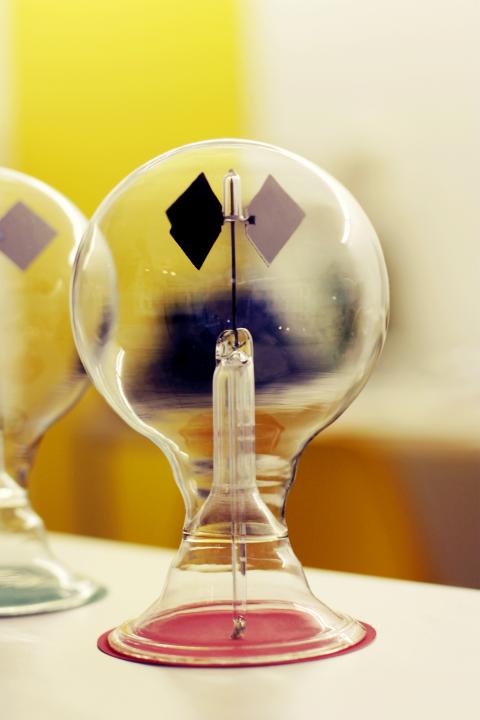
Photo: Catherine Shu, Taipei Times
“When we were hunting for these things, it really helped open our eyes,” says Wu. “We hope [Ordinary Beauty] will inspire people to take a closer look at the objects next to them.”
Paging design history: The Itis Edition store
The front part of Itis Edition’s studio on a Xinyi District sidestreet is dedicated to secondhand books about art and design, most dating from the 1960s and 1970s and sourced from used book dealers in the US. They are carefully arranged on shelves, their covers facing outwards like works of art.
Wu, an illustrator, has a fondness for picture books. The store’s stock currently includes a copy of The Happy Lion by husband-and-wife team Louise Fatio and Roger Duvoisin and Misery for Everybody, a 1970 humor book in which Suzanne Heller’s line drawings capture various depressing situations (“Misery is when you have a beautiful mother but you look like your father”).
Several volumes feature one of Wu’s favorite artists, Lithunian American Ben Shahn. Along with photographers Walker Evans and Dorothea Lange, Shahn documented the American South for the Farm Security Administration during the Great Depression and much of his artwork was influenced by his left-leaning politics.
There are also catalogs from industrial design exhibitions and reference volumes such as a copy of Designers in Britain from 1967. Inside are photos of products that were then considered at the cutting edge of industrial design, including a Ford Consul and an FM/AM signal generator by the now-defunct Marconi Instruments. Non-English volumes include the 1957/1958 edition of Graphis Annual, a roundup of graphic design created in Switzerland during those two years.
Wu says she doesn’t focus on any time period in particular when looking for books to sell in the store, but is constantly drawn to volumes published during the 1960s and 1970s.
“I felt design back then was much more friendly, but 1980s design is a bit frightening,” says Wu. “In the 1960s, you can see the influence of the space age and everything was much more colorful and charming.”
STORE NOTES
WHAT: Itis Edition (版語空間)
WHERE: 293-1 Jiaxing St, Taipei City (台北市嘉興街293-1號)
OPEN: Thursday to Saturday from noon to 6pm. Call ahead to make sure the store is open
TELEPHONE: (02) 2735-2251
ON THE NET: www.itisedition.com
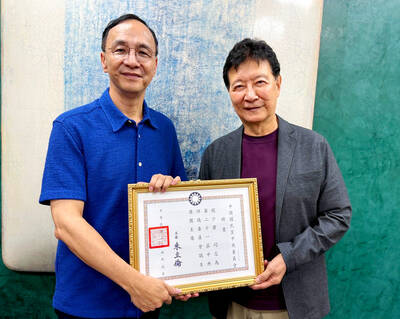
Next week, candidates will officially register to run for chair of the Chinese Nationalist Party (KMT). By the end of Friday, we will know who has registered for the Oct. 18 election. The number of declared candidates has been fluctuating daily. Some candidates registering may be disqualified, so the final list may be in flux for weeks. The list of likely candidates ranges from deep blue to deeper blue to deepest blue, bordering on red (pro-Chinese Communist Party, CCP). Unless current Chairman Eric Chu (朱立倫) can be convinced to run for re-election, the party looks likely to shift towards more hardline
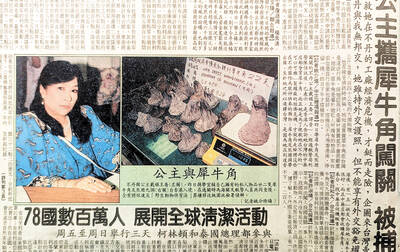
Sept. 15 to Sept. 21 A Bhutanese princess caught at Taoyuan Airport with 22 rhino horns — worth about NT$31 million today — might have been just another curious front-page story. But the Sept. 17, 1993 incident came at a sensitive moment. Taiwan, dubbed “Die-wan” by the British conservationist group Environmental Investigation Agency (EIA), was under international fire for being a major hub for rhino horn. Just 10 days earlier, US secretary of the interior Bruce Babbitt had recommended sanctions against Taiwan for its “failure to end its participation in rhinoceros horn trade.” Even though Taiwan had restricted imports since 1985 and enacted
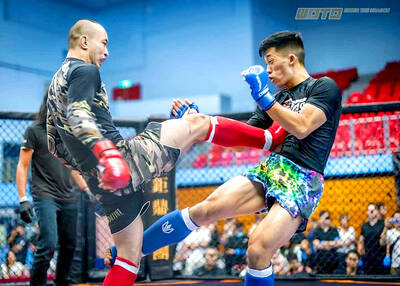
Enter the Dragon 13 will bring Taiwan’s first taste of Dirty Boxing Sunday at Taipei Gymnasium, one highlight of a mixed-rules card blending new formats with traditional MMA. The undercard starts at 10:30am, with the main card beginning at 4pm. Tickets are NT$1,200. Dirty Boxing is a US-born ruleset popularized by fighters Mike Perry and Jon Jones as an alternative to boxing. The format has gained traction overseas, with its inaugural championship streamed free to millions on YouTube, Facebook and Instagram. Taiwan’s version allows punches and elbows with clinch striking, but bans kicks, knees and takedowns. The rules are stricter than the

Nearly three decades of archaeological finds in Gaza were hurriedly evacuated Thursday from a Gaza City building threatened by an Israeli strike, said an official in charge of the antiquities. “This was a high-risk operation, carried out in an extremely dangerous context for everyone involved — a real last-minute rescue,” said Olivier Poquillon, director of the French Biblical and Archaeological School of Jerusalem (EBAF), whose storehouse housed the relics. On Wednesday morning, Israeli authorities ordered EBAF — one of the oldest academic institutions in the region — to evacuate its archaeological storehouse located on the ground floor of a residential tower in